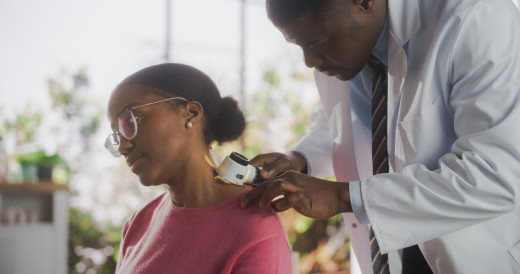February 5th, 2024

By: Juliann S. Wallner, M.D., board-certified dermatologist
Even as the most common cancer in the United States, skin cancer is also one of the most preventable, and highly treatable when caught early.
Regularly checking your skin for irregularities during a self-examination is a best practice in catching skin cancer early. Self-examinations include becoming familiar with all moles, age spots and freckles on your body. In doing so, spotting an irregularity will become easier.
Melanoma is the deadliest form of skin cancer, and it is important to familiarize yourself with its warning signs during your self-examination. An easy way to remember the warning signs of melanoma is the ABCDEs from the American Academy of Dermatology:
- Asymmetry: One half of the mole is unlike the other half.
- Border: The mole has irregular, scalloped or poorly defined borders.
- Color: The color of the mole varies from one area to another. It can be shades of tan, brown, and black, or sometimes white, red, or blue.
- Diameter: Typically, melanoma is greater than 6 mm, or the size of a pencil eraser; however, when diagnosed, it can be smaller.
- Evolving: A mole or skin lesion that looks different or is changing in size, shape or color.
If during your self-examination you find one of the above, it is imperative to follow up with a skin check by a board-certified dermatologist.
Skin checks may be recommended more of if you are at a higher risk of skin cancer or have the following:
- A strong family or personal history of skin cancer
- Abnormal skin check
- Extensive sun exposure
- Blistering sunburns
- Hundreds of moles
- Are immunosuppressed such as patients undergoing chemotherapy, an organ transplant, or diagnosed with lymphoma or leukemia
Children with a strong family history of skin cancer, blistering sunburns, or hundreds of moles should get a baseline skin check at age 13. Even though skin cancer is rare in children, any mole that is growing more rapidly than the child, changing in symmetry or color, or scabs and bleeds should also be evaluated.
If a skin check is normal, the American Cancer Society recommends people between the ages of 20 and 40 get a professional skin exam every three years and jumps to once a year for people over the age of 40. If a patient has an abnormal skin check and basal cell carcinoma or squamous cell carcinoma is found, they should get routine skin checks every six months, and if invasive melanoma is found patients should be seen every three months.
In between routine skin checks, if a patient notices a lesion consistently drawing their attention such as persistently itchy or painful, bleeds or scabs or doesn’t heal, they should contact their dermatology office immediately. Additionally, if they find a mole enlarging asymmetrically, developing colors such as red, blue, black or white, or if the border becomes blurred or fuzzy, it is also recommended to see their dermatologist.
Dr. Jullian S. Wallner is a board-certified dermatologist at Pinehurst Medical Clinic providing medical and cosmetic dermatology care.
Back





